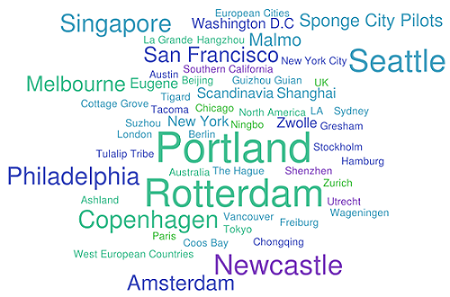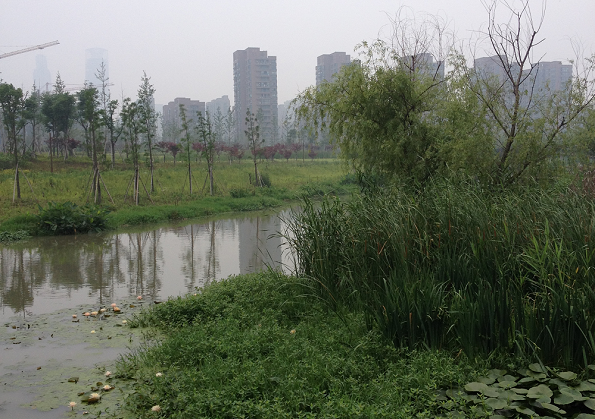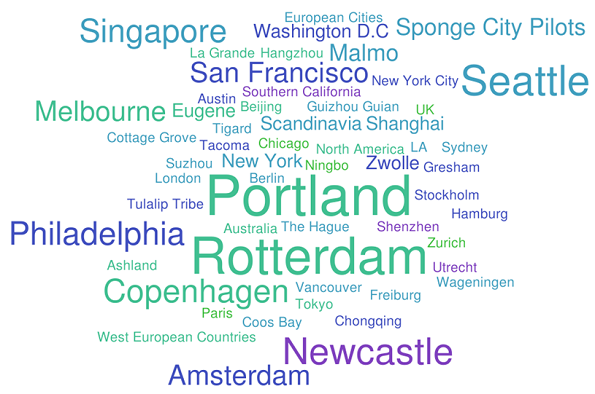
May 30, 2019, by Blue-Green team
Who are the international leaders in Blue-Green infrastructure?
As the multiple co-benefits of Blue-Green infrastructure become more widely recognised and acknowledged, more and more cities are incorporating these approaches into their strategies to tackle environmental and social challenges. Emily O’Donnell explores further in this blog.
Multiple co-benefits of Blue-Green infrastructure
As an example, the Ningbo (China) Eco-Corridor project (led by the Ningbo Planning and Design Research Institution) uses Blue-Green infrastructure to transform a 3.3 km brownfield site into a ‘living filter’. This helps to manage the city’s flood risk while restoring ecosystems and creating better synergy between human activity and wildlife (SWA 2018).

Ningbo Eco-Corridor (photo: E. O’Donnell, June 2015)
In Leicester (UK) the Ellis Meadows scheme reduces flood risk to over 2000 homes and businesses, and was highly commended for best practice in large-scale practical nature conservation by the Chartered Institute of Ecology and Environmental Management (CIEEM). This again shows how Blue-Green flood risk management schemes may meet other city objectives, in this case, creating new habitats and enhancing biodiversity in an area of poor ecological value to help deliver the Leicester Biodiversity Action Plan 2011-2021.
As another example, many policies in Rotterdam (the Netherlands) over the last decade for strengthening Blue-Green infrastructure focus on how this may improve the quality of live in the city. The Rotterdam Waterplan 2 (2007) and subsequent Water Sensitive Rotterdam Programme (2015) use Blue-Green infrastructure to improve the cityscape and encourage interaction with water, while managing flood risk, improving water quality, and reusing rainwater.
These examples (and many others in cities worldwide) show that Blue-Green projects are definitely not restricted to just managing water and flood risk.
So who are the international Blue-Green infrastructure leaders?
The Blue-Green Futures project team are currently analysing the responses from a questionnaire exploring the perceived benefits, beneficiaries, multifunctionality and associated challenges of planning and delivering Blue-Green infrastructure. The questionnaire was completed by professional stakeholders in our four case study cities: Newcastle (UK), Ningbo (China), Portland (Oregon) and Rotterdam (the Netherlands). One question asked “Which cities are leading in BGI implementation?” The responses are shown in the figure below.

A word cloud detailing cities acknowledged by our questionnaire respondents as leading in Blue-Green infrastructure implementation.
Key trends
Portland and Rotterdam certainly stand out as cities acknowledged by many of our questionnaire respondents as BGI leaders. Portland; due to its extensive use of green infrastructure to manage stormwater and reduce combined sewer overflows (e.g. the ‘Grey to Green’ initiative), and Rotterdam; through its extensive research and investment into climate change adaptation and pioneering blue, green and grey infrastructure to manage risk and deliver benefits to society (e.g. the renowned Benthemplein Water Plaza).
The questionnaire responses suggests a lot of local support for Blue-Green infrastructure in Newcastle and the Chinese Sponge Cities. Other US cities – Seattle (Green Stormwater Infrastructure), Philadelphia (Green City, Clean Waters) and San Francisco (Green Infrastructure Projects) – are acknowledged as are cities further afield, including Singapore (Active, Beautiful, Clean Water Programme) and Melbourne (Green Infrastructure Projects).
Blue-Green infrastructure best practice is certainly evident on a global scale.
Follow our blogs for more insight into our research findings plus information on Blue-Green infrastructure progress, events and related research and practice.
No comments yet, fill out a comment to be the first

Leave a Reply